Abstract
A total of 250 cerebrospinal fluid (CSF) specimens were analyzed using a rapid enzyme immunoassay (Pharmacia Meningitis EIA-Test) (EIA) for the detection of antigens of Haemophilus influenzae type b, Neisseria meningitidis (serogroups A,B,C) and Streptococcus pneumoniae (25 selected types). The test is performed in less than 1 h and read by the naked eye. EIA and coagglutination (CoA) were compared with a constructed reference that comprised samples which were either positive by culture and/or on direct microscopy (DM), or in which there were positive results with both EIA and CoA for the bacteria covered by the assays. Using this reference for CSF samples assayed in a period between two meningococcal meningitis epidemics, the sensitivity was 0.86 for EIA and 0.69 for CoA, the specificity 0.95 (EIA) and 0.97 (CoA), the predictive value for a positive result 0.81 (EIA) and 0.87 (CoA) and, the predictive value for a negative result 0.96 (EIA) and 0.93 (CoA). Antibiotics had been given to 54% of the patients before admission. All of the 56 samples that were positive in any of the tests taken during an epidemic of group A meningococcal disease were detected by EIA; CoA was negative in 45% and culture/DM was negative in 32%. Sequential dilutions of two CSF samples from which H. influenzae type b had been isolated, showed the EIA to be 16-32 times more sensitive than CoA. With both technical feasibility and good sensitivity and specificity, the EIA seems to be useful and reliable for the rapid diagnosis of bacterial meningitis, especially in situations where pretreatment with antibiotics are likely.
Full text
PDF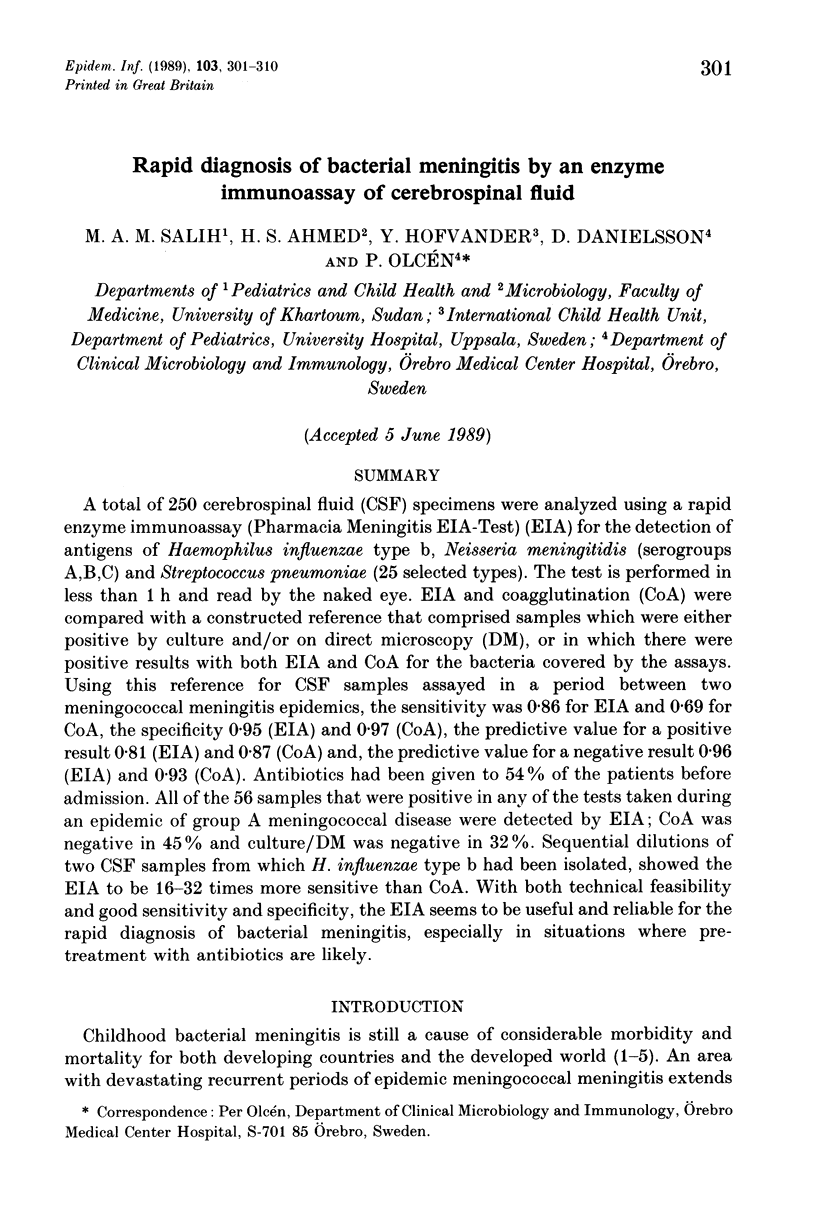
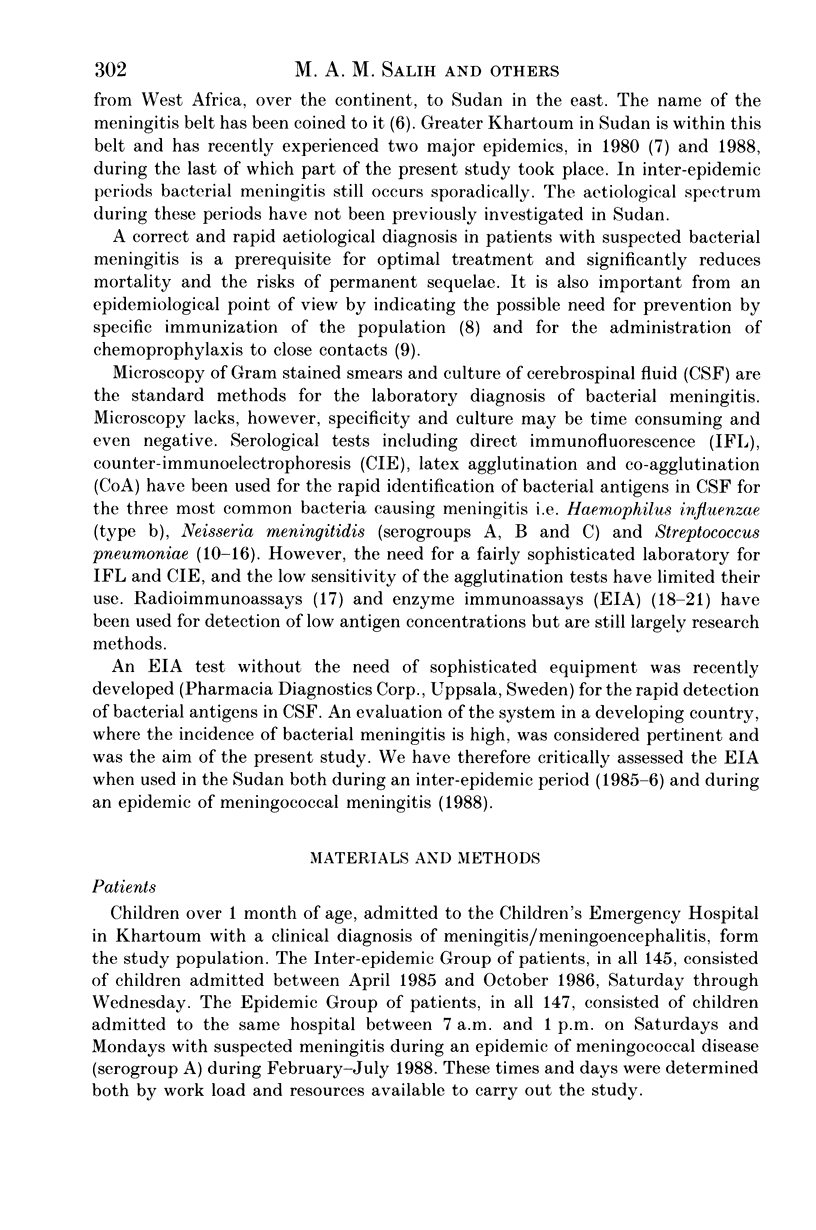
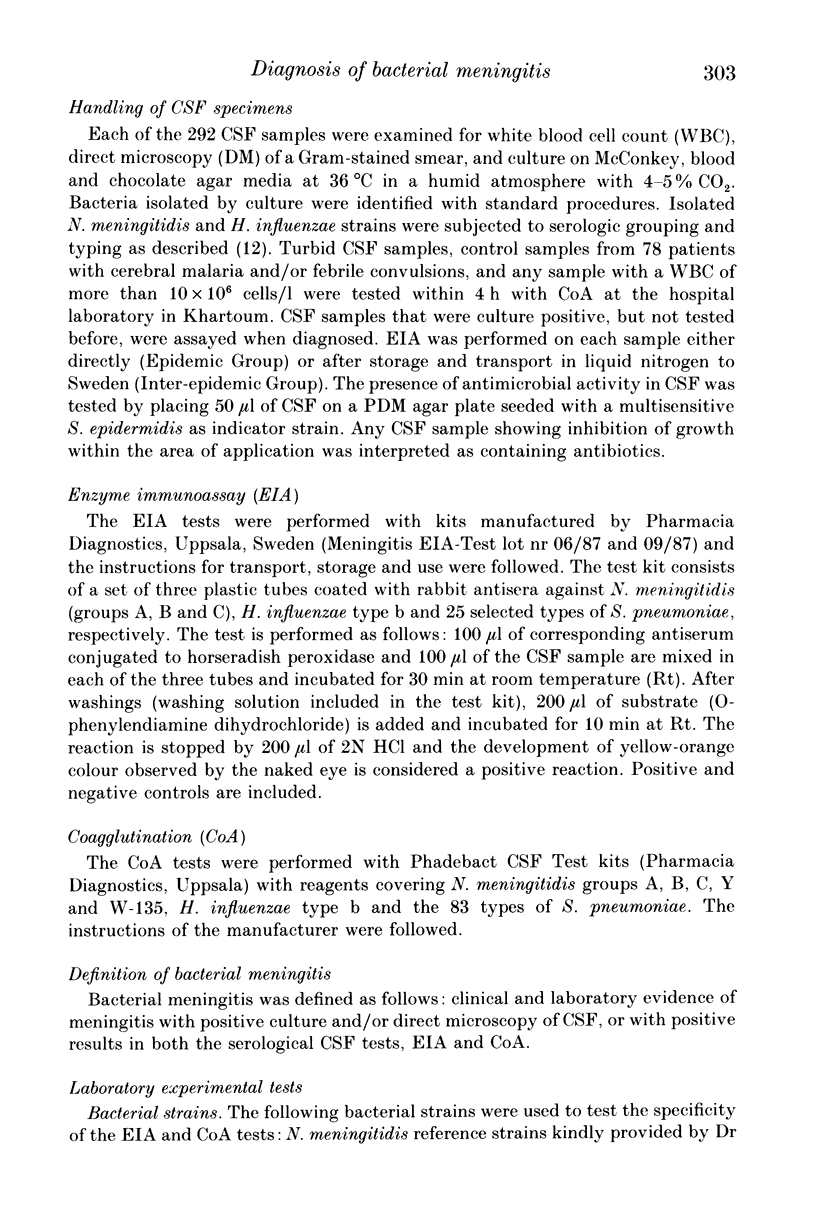
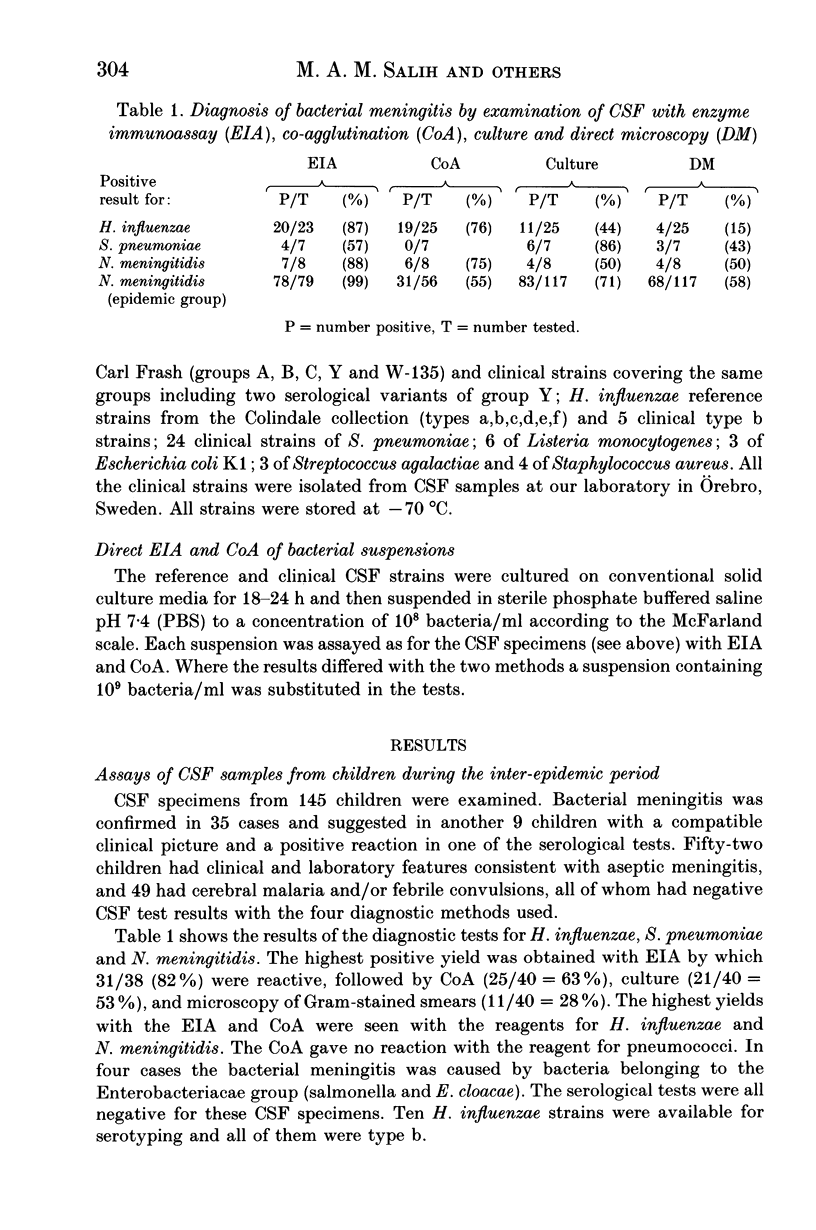
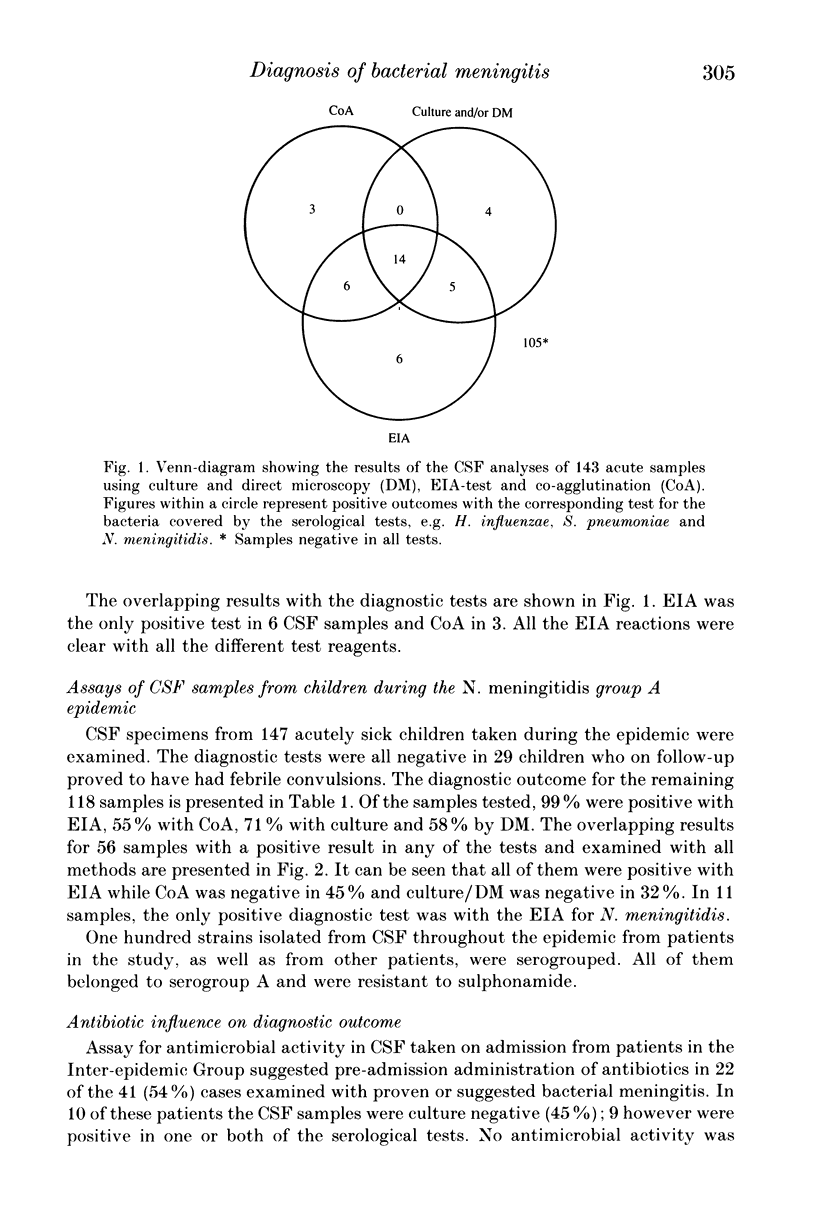
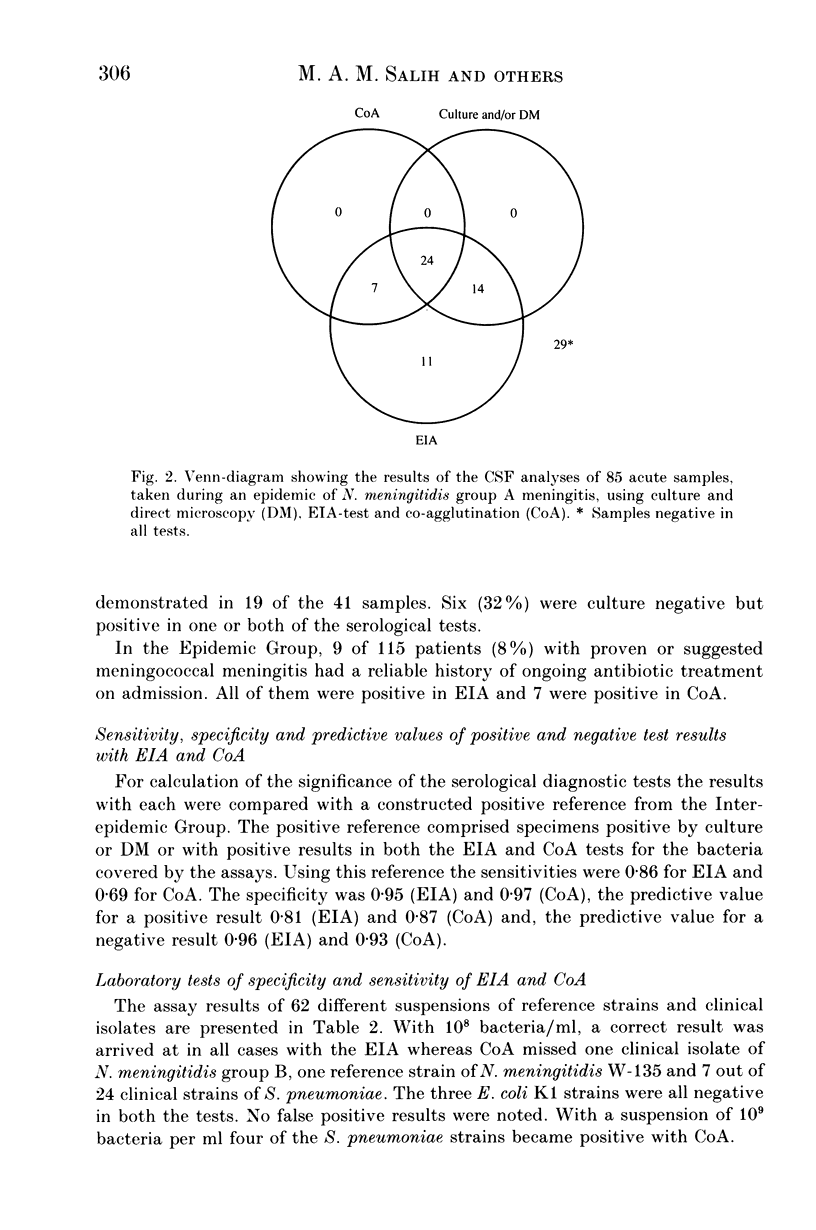
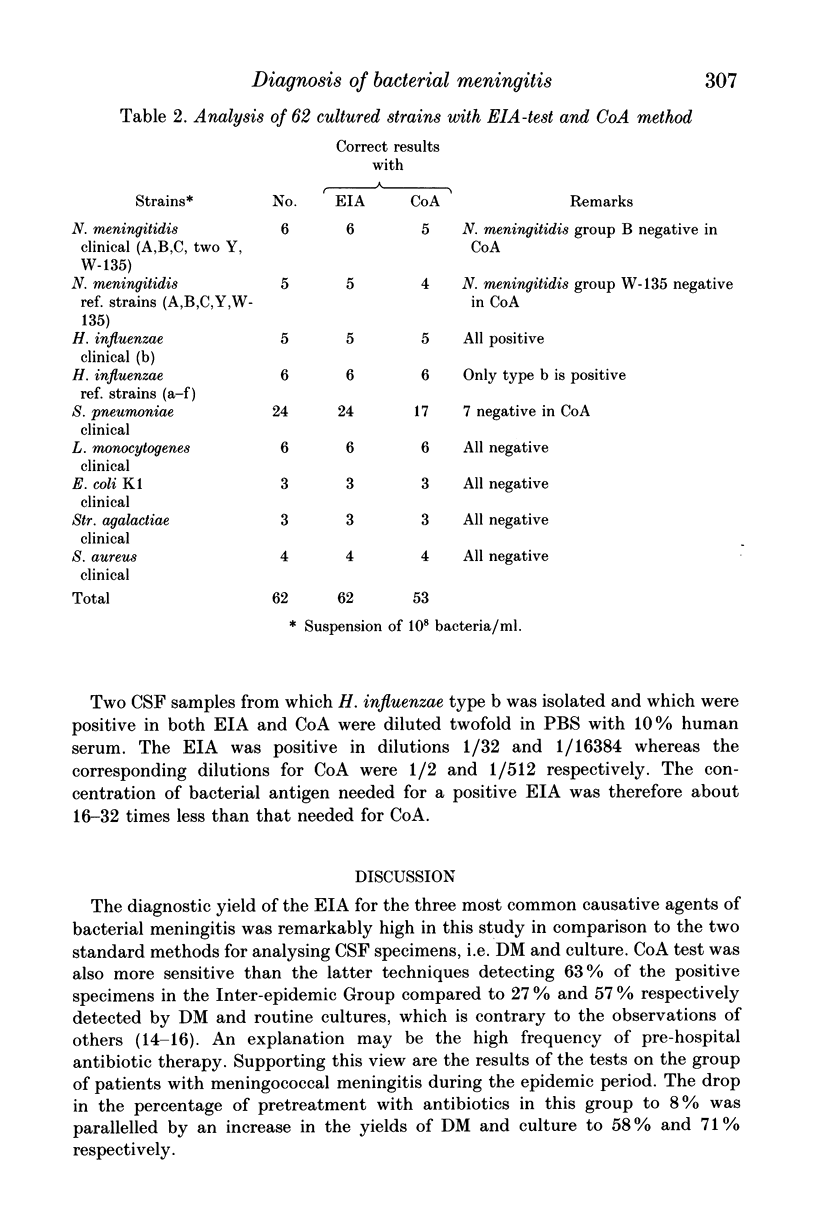
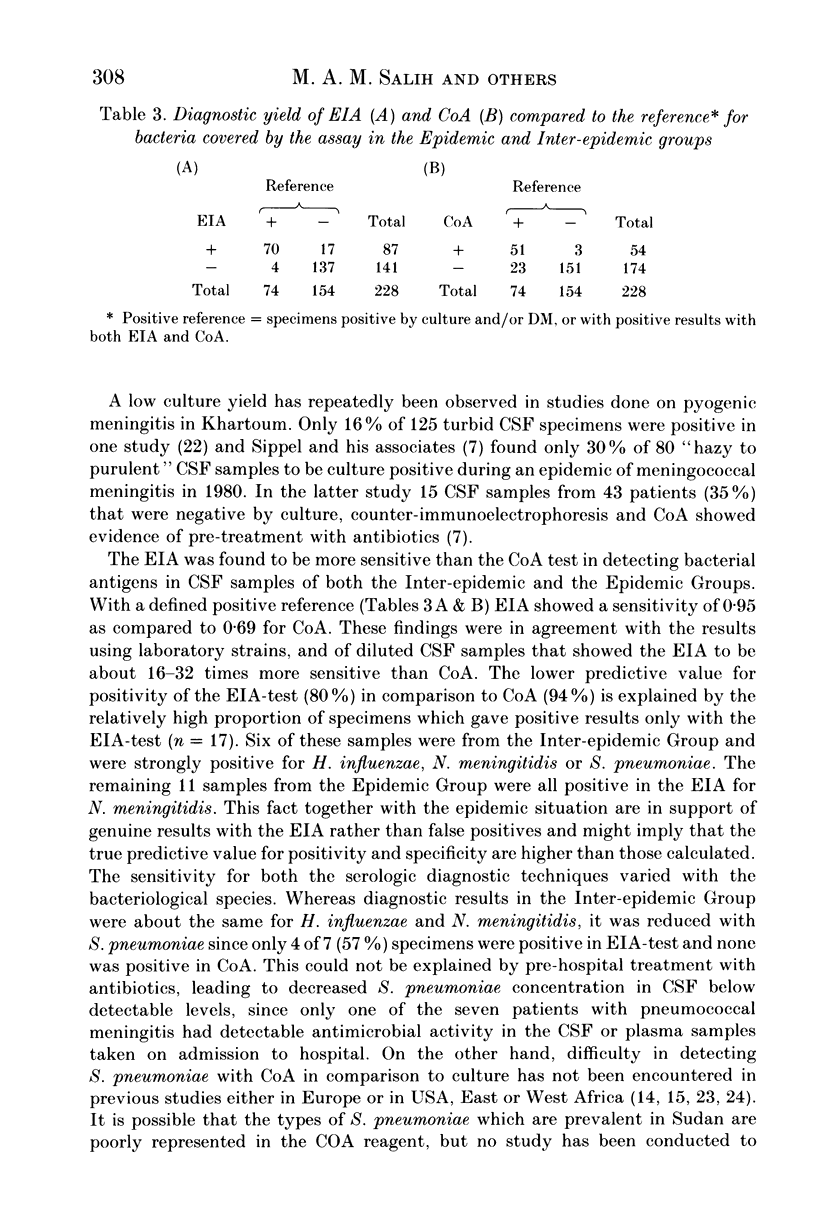
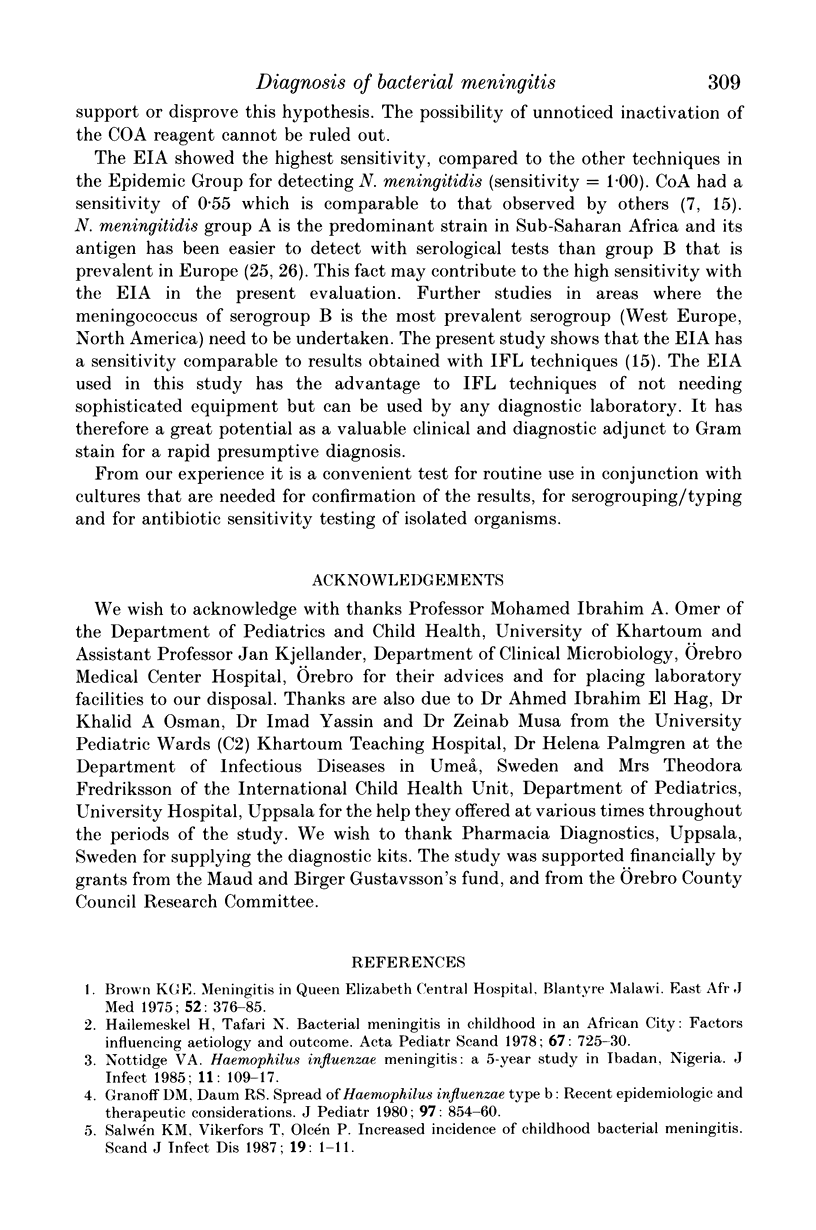
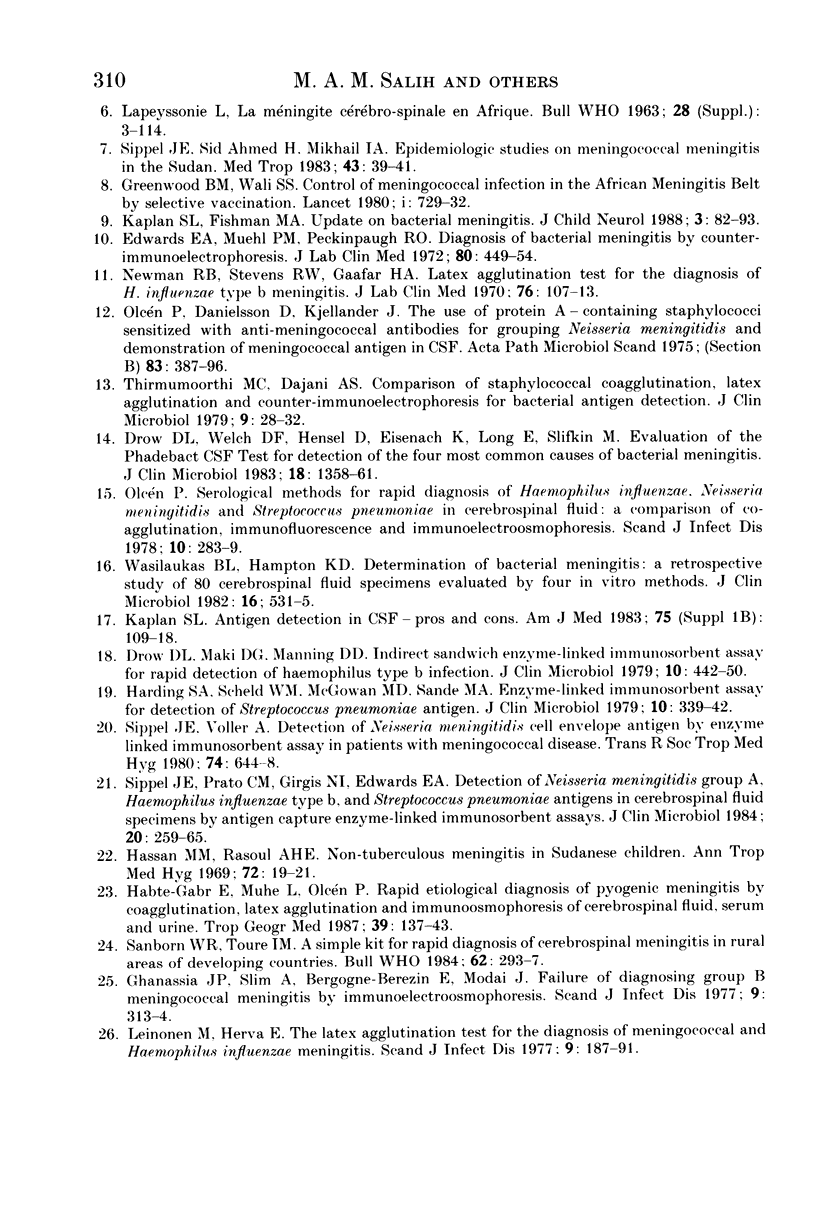
Selected References
These references are in PubMed. This may not be the complete list of references from this article.
- Brown K. G. Meningitis in Queen Elizabeth Central Hospital, Blantyre, Malawi. East Afr Med J. 1975 Jul;52(7):376–385. [PubMed] [Google Scholar]
- Drow D. L., Maki D. G., Manning D. D. Indirect sandwich enzyme-linked immunosorbent assay for rapid detection of Haemophilus influenzae type b infection. J Clin Microbiol. 1979 Oct;10(4):442–450. doi: 10.1128/jcm.10.4.442-450.1979. [DOI] [PMC free article] [PubMed] [Google Scholar]
- Drow D. L., Welch D. F., Hensel D., Eisenach K., Long E., Slifkin M. Evaluation of the Phadebact CSF test for detection of the four most common causes of bacterial meningitis. J Clin Microbiol. 1983 Dec;18(6):1358–1361. doi: 10.1128/jcm.18.6.1358-1361.1983. [DOI] [PMC free article] [PubMed] [Google Scholar]
- Edwards E. A., Muehl P. M., Peckinpaugh R. O. Diagnosis of bacterial meningitis by counterimmunoelectrophoresis. J Lab Clin Med. 1972 Sep;80(3):449–454. [PubMed] [Google Scholar]
- Ghanassia J. P., Slim A., Bergogne-Berezin E., Modai J. Failure of diagnosing group B meningococcal meningitis by immunoelectroosmophoresis. Scand J Infect Dis. 1977;9(4):313–314. doi: 10.3109/inf.1977.9.issue-4.12. [DOI] [PubMed] [Google Scholar]
- Granoff D. M., Daum R. S. Spread of Haemophilus influenzae type b: recent epidemiologic and therapeutic considerations. J Pediatr. 1980 Nov;97(5):854–860. doi: 10.1016/s0022-3476(80)80288-5. [DOI] [PubMed] [Google Scholar]
- Greenwood B. M., Wali S. S. Control of meningococcal infection in the African meningitis belt by selective vaccination. Lancet. 1980 Apr 5;1(8171):729–732. doi: 10.1016/s0140-6736(80)91230-1. [DOI] [PubMed] [Google Scholar]
- Habte-Gabr E., Muhe L., Olcen P. Rapid etiological diagnosis of pyogenic meningitis by coagglutination, latex agglutination and immunoosmophoresis of cerebrospinal fluid, serum and urine. Trop Geogr Med. 1987 Apr;39(2):137–143. [PubMed] [Google Scholar]
- Hailemeskel H., Tafari N. Bacterial meningitis in childhood in an African city. Factors influencing aetiology and outcome. Acta Paediatr Scand. 1978 Nov;67(6):725–730. doi: 10.1111/j.1651-2227.1978.tb16250.x. [DOI] [PubMed] [Google Scholar]
- Harding S. A., Scheld W. M., McGowan M. D., Sande M. A. Enzyme-linked immunosorbent assay for detection of Streptococcus pneumoniae antigen. J Clin Microbiol. 1979 Sep;10(3):339–342. doi: 10.1128/jcm.10.3.339-342.1979. [DOI] [PMC free article] [PubMed] [Google Scholar]
- Hassan M. M., el-Rasoul A. H. Non-tuberculous meningitis in Sudanese children. J Trop Med Hyg. 1969 Jan;72(1):19–21. [PubMed] [Google Scholar]
- Kaplan S. L. Antigen detection in cerebrospinal fluid--pros and cons. Am J Med. 1983 Jul 28;75(1B):109–118. doi: 10.1016/0002-9343(83)90081-5. [DOI] [PubMed] [Google Scholar]
- Kaplan S. L., Fishman M. A. Update on bacterial meningitis. J Child Neurol. 1988 Apr;3(2):82–93. doi: 10.1177/088307388800300202. [DOI] [PubMed] [Google Scholar]
- Leinonen M., Herva E. The latex agglutination test for the diagnosis of meningococcal and haemophilus influenzae meningitis. Scand J Infect Dis. 1977;9(3):187–191. doi: 10.3109/inf.1977.9.issue-3.06. [DOI] [PubMed] [Google Scholar]
- Newman R. B., Stevens R. W., Gaafar H. A. Latex agglutination test for the diagnosis of Haemophilus influenzae meningitis. J Lab Clin Med. 1970 Jul;76(1):107–113. [PubMed] [Google Scholar]
- Nottidge V. A. Haemophilus influenzae meningitis: a 5-year study in Ibadan, Nigeria. J Infect. 1985 Sep;11(2):109–117. doi: 10.1016/s0163-4453(85)91931-0. [DOI] [PubMed] [Google Scholar]
- Olcén P., Danielsson D., Kjellander J. The use of protein A-containing staphylococci sensitized with anti-meningococcal antibodies for grouping Neisseria meningitidis and demonstration of meningococcal antigen in cerebrospinal fluid. Acta Pathol Microbiol Scand B. 1975 Aug;83(4):387–396. doi: 10.1111/j.1699-0463.1975.tb00117.x. [DOI] [PubMed] [Google Scholar]
- Olcén P. Serological methods for rapid diagnosis of haemophilus influenzae, Neisseria meningitidis and Streptococcus pneumoniae in cerebrospinal fluid: a comparison of Co-agglutination, immunofluorescence and immunoelectroosmophoresis. Scand J Infect Dis. 1978;10(4):283–289. doi: 10.3109/inf.1978.10.issue-4.05. [DOI] [PubMed] [Google Scholar]
- Salwén K. M., Vikerfors T., Olcén P. Increased incidence of childhood bacterial meningitis. A 25-year study in a defined population in Sweden. Scand J Infect Dis. 1987;19(1):1–11. doi: 10.3109/00365548709032371. [DOI] [PubMed] [Google Scholar]
- Sanborn W. R., Touré I. M. A simple kit system for rapid diagnosis of cerebrospinal meningitis in rural areas of developing countries. Bull World Health Organ. 1984;62(2):293–299. [PMC free article] [PubMed] [Google Scholar]
- Sippel J. E., Prato C. M., Girgis N. I., Edwards E. A. Detection of Neisseria meningitidis group A, Haemophilus influenzae type b, and Streptococcus pneumoniae antigens in cerebrospinal fluid specimens by antigen capture enzyme-linked immunosorbent assays. J Clin Microbiol. 1984 Aug;20(2):259–265. doi: 10.1128/jcm.20.2.259-265.1984. [DOI] [PMC free article] [PubMed] [Google Scholar]
- Sippel J. E., Voller A. Detection of Neisseria meningitidis cell envelope antigen by enzyme-linked immunosorbent assay in patients with meningococcal disease. Trans R Soc Trop Med Hyg. 1980;74(5):644–648. doi: 10.1016/0035-9203(80)90156-x. [DOI] [PubMed] [Google Scholar]
- Thirumoorthi M. C., Dajani A. S. Comparison of staphylococcal coagglutination, latex agglutination, and counterimmunoelectrophoresis for bacterial antigen detection. J Clin Microbiol. 1979 Jan;9(1):28–32. doi: 10.1128/jcm.9.1.28-32.1979. [DOI] [PMC free article] [PubMed] [Google Scholar]
- Wasilauskas B. L., Hampton K. D. Determination of bacterial meningitis: a retrospective study of 80 cerebrospinal fluid specimens evaluated by four in vitro methods. J Clin Microbiol. 1982 Sep;16(3):531–535. doi: 10.1128/jcm.16.3.531-535.1982. [DOI] [PMC free article] [PubMed] [Google Scholar]


